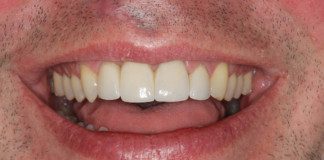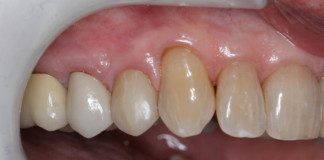 When a tooth is missing, a replacement tooth should be put into the open space in order to maintain proper dental alignment and health. (Of course, this also serves an aesthetic need.)
When a tooth is missing, a replacement tooth should be put into the open space in order to maintain proper dental alignment and health. (Of course, this also serves an aesthetic need.)
There are several treatment options for replacing a single tooth:
- A single tooth implant and crown (the standard of care. It looks, feels and functions just like a natural tooth)
- A traditional 3-tooth bridge (which involves grinding down both adjacent teeth)
- A cantilevered bridge (not very strong)
- A Maryland bridge (not very strong)
- A removable partial denture/flipper (not a good long-term option and not good for back teeth)
Let’s compare the pros and cons of all of these options in detail:
A single tooth dental implant and crown
. This is by far, the best option, but requires enough bone to put the implant into. A dental implant is a small screw that replaces the ROOT of the tooth, onto which a customized crown is placed. This is the standard of care today. It is the ideal way to replace a single missing tooth without damaging the gum tissues or drilling down the surrounding teeth. It is a permanent solution. Unlike crowns on natural teeth that need replacing from time to time, these do not, because they do not decay!
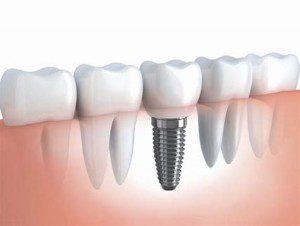
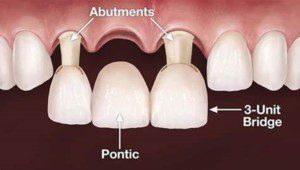
A traditional 3-tooth bridge
consists of a false tooth, called a “pontic” being “bridged” between dental crowns that are cemented onto the two adjacent teeth. There is a downside to traditional bridges. In order to use the adjacent abutment teeth to support the bridge, your dentist will need to file them down to make room for the crowns on top. Additionally, bridges often need to be replaced years down the road, so, unfortunately, it is not a one-time fix.
A cantilever bridge
is similar to a traditional 3-tooth bridge, but only has two teeth on it; the false tooth (pontic), and one supporting abutment tooth. Because cantilevered bridges are only supported on one side, the risks are much higher for complications like fracturing the supporting tooth or it coming loose frequently from the uneven torque placed on them while chewing. This is not recommended very often anymore, because it pretty much means eventual doom for the supporting tooth, typically resulting in the loss of it.
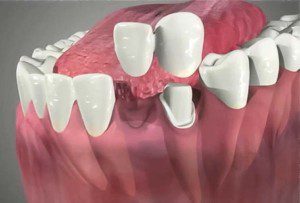
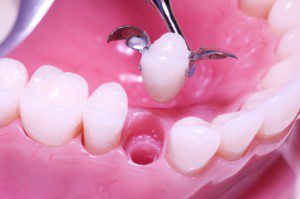
A Maryland bridge
is sometimes used to replace a single missing front tooth. It looks like a single tooth with wings on each side. The little “wing-like” extensions on each side of it are resin-bonded onto the back side of the adjacent teeth. They are considered a more conservative alternative to traditional bridges, because since they don’t need to be held in place by crowns, they do not require the grinding down of the adjacent teeth. The downside of this is that Maryland bridges are not nearly as durable as traditional bridges or implants. The Maryland bridge is only as strong as the binding material that holds it together, so it may not stay in place for long periods of time. These are not used to replace back teeth, as the biting forces are just too much for them to withstand.
A removable partial denture or “flipper”.
A flipper tooth is essentially a partial denture, but the term flipper generally refers to a single tooth partial denture and a partial denture refers to a denture for more than one missing tooth. Also, a flipper is just acrylic, whereas a partial denture has a metal frame and clasps that wrap around adjacent teeth The main difference between the two is that a flipper tooth is a temporary denture you wear while you wait for a more permanent denture solution.
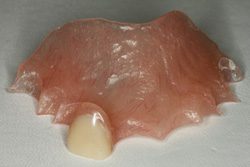
What is a Single Tooth Replacement?
For patients missing or soon to be missing a single tooth, a Single Dental Implant Restoration is the ideal solution. There are multiple treatment options to consider when replacing a missing tooth, but dental implants are a permanent, worry-free solution. Consisting of a small screw and a customized crown, dental implants are ideal for replacing single teeth without impairing gum health or damaging surrounding teeth.
What Can I Expect During the Single Tooth Implant Process?
- Dental Implant Placement: Local anesthesia will be administered to numb your mouth so you won’t feel anything during the procedure. You can opt for IV sedation, as well, if you choose. Once you are numb, a small incision will be made in the gum tissue, a small hole will be drilled in the jawbone and the dental implant will be screwed in place and left to heal for a few months. In many cases, we are able to attach a temporary crown that same day. (Whether or not this is an option for you and your particular situation, will be determined at your consultation and diagnostic visit.)
- Abutment Placement: The abutment will be attached to the implant and a final impression will be made to fabricate the crown from. We will select the shade and take photographs to send the lab This helps with any custom staining and matching of other teeth for a natural looking result.
- Dental Crown Placement: Once your porcelain implant crown is back from the lab, we will attach it to the abutment post, make any bite adjustments necessary and you’re done!.
Modern dental implant technology and procedures allow most single tooth implant patients, even those with a failing tooth to have an implant and temporary crown the same day. This scenario creates a seamless treatment with the patient usually leaving with a much better tooth than the original. After a few weeks, a permanent implant crown can be delivered to replace the temporary crown. The permanent crown is either screw or cement retained. Screw retention is the preferred method because it is more hygienic.
Benefits of Single Tooth Implant Replacement:
- No damage to natural teeth (compared to tooth bridge)
- Maintenance of Bone Volume (the implant preserves the bone)
- Less Force on Surrounding Teeth (the implant strengthens the surrounding teeth/arch)
- Better Aesthetic Outcome (if the implant is properly positioned)
- Less traumatic and less expensive in the long term
- You don’t have to worry about them while eating or speaking
- They last a lifetime, if maintained properly
- They look, feel and function just like a natural tooth.
- Once it’s healed, you don’t even feel it!
- They don’t move or slide in your mouth
- You don’t have to do anything extra to maintain them. Regular oral hygiene (brushing and flossing) is enough.
- They improve your self-esteem and confidence because they’re both strong and they look great
- People won’t even know you have dental implants
How Will The New Implant Crown Look?
The new implant crown should match the opposing natural teeth within 95%. Our goal is to match the adjacent natural teeth exactly. However, there are so many variations in natural teeth that it is not always possible to match them 100%. The less-than-perfect goal is to have the tooth blend in with the surrounding teeth so that the vast majority of people will never be able to pick the implant crown. If your implant crown is noticeable then your dentist or their lab did not try hard enough!
Why Choose Single Tooth Replacement at The Dental Implant Center?
Many dentists and lab technicians agree that replacing a single, upper central incisor is the most difficult procedure in all of dentistry. This saying originated before implants. The use of porcelain to match enamel, even in the hands of an expert dental technician (ceramist) is a daunting task. The implant position, color and contour further complicate the challenge. There is no doubt that experience, tenacity and a commitment to excellence helps the process. Here, at this practice we do not stop until everyone agrees that the color matching process is as close as humanly possible.
What is the cost for single tooth implant?
The cost varies greatly depending upon the region, doctor’s training, implant type, number of implants, the need for bone grafting and type of material used for the final restoration. For Single Tooth Implant Replacement the cost range will be, $3,500 – 7500.
Contact us today to schedule a consultation and find out how our single tooth implant services can benefit your oral health and appearance.
To learn more about Single Tooth Replacement and how we can help you please fill out the form below.


